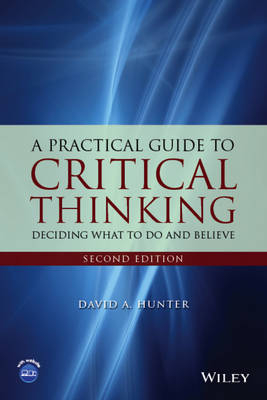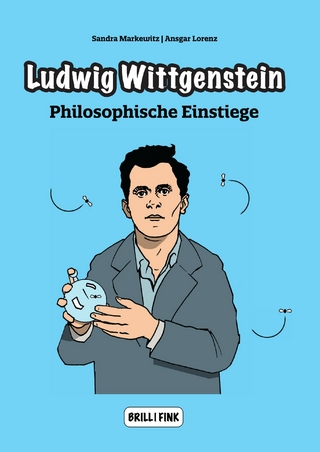
A Practical Guide to Critical Thinking
John Wiley & Sons Inc (Verlag)
9781118583081 (ISBN)
A thoroughly updated introduction to the concepts, methods, and standards of critical thinking, A Practical Guide to Critical Thinking: Deciding What to Do and Believe, Second Edition is a unique presentation of the formal strategies used when thinking through reasons and arguments in many areas of expertise. Pursuing an interdisciplinary approach to critical thinking, the book offers a broad conception of critical thinking and explores the practical relevance to conducting research across fields such as, business, education, and the biological sciences.
Applying rigor when necessary, the Second Edition maintains an informal approach to the fundamental core concepts of critical thinking. With practical strategies for defining, analyzing, and evaluating reasons and arguments, the book illustrates how the concept of an argument extends beyond philosophical roots into experimentation, testing, measurement, and policy development and assessment. Featuring plenty of updated exercises for a wide range of subject areas, A Practical Guide to Critical Thinking Deciding What to Do and Believe, Second Edition also includes:
Numerous real-world examples from many fields of research, which reflect the applicability of critical thinking in everyday life
New topical coverage, including the nature of reasons, assertion and supposing, narrow and broad definitions, circumstantial reasons, and reasoning about causal claims
Selected answers to various exercises to provide readers with instantaneous feedback to support and extend the lessons
A Practical Guide to Critical Thinking Deciding What to Do and Believe, Second Edition is an excellent textbook for courses on critical thinking and logic at the undergraduate and graduate levels as well as an appropriate reference for anyone with a general interest in critical thinking skills.
David A. Hunter, PhD, is Associate Professor of Philosophy at Ryerson University, Canada. He has published numerous journal articles in his areas of research interest, which include the philosophy of language, the philosophy of mind, epistemology, and critical thinking.
Preface xiii
Preface to First Edition xv
Note to Instructors xvii
1 The Nature and Value of Critical Thinking 1
1.1 The Nature of Critical Thinking 2
Exercise 1 5
1.2 Critical Thinking and Knowledge 6
Exercise 2 6
1.3 Knowledge and Truth 7
1.3.1 Realism Relativism and Nihilism 8
1.3.2 Relativism and the Argument from Disagreement 11
1.4 Knowledge and Belief 14
1.5 Knowledge and Justification 16
1.5.1 Emotional and Pragmatic Reasons 17
1.5.2 Epistemic Reasons 18
1.5.3 Emotions and Evidence 20
1.6 Good Reasons are Sufficient and Acceptable 22
1.7 When Evidence Conflicts 23
Exercise 3 26
1.8 Critical Thinking and Personal Autonomy 27
1.8.1 Belief and Prejudice 27
1.8.2 Making Up Your Own Mind 28
Chapter Exercises 30
1.9 Critical Thinking in Practice 32
1.9.1 Critical Thinking Mistakes 32
1.9.2 Critical Thinking Strategies 34
1.9.3 From Theory to Practice: Applying What We Have Learned 34
2 Clarifying Meaning 37
2.1 The Place of Definitions in Critical Thinking 37
2.2 Assertion 39
Exercise 1 41
2.3 The Assertion Test 41
Exercise 2 45
2.4 Constructing and Evaluating Definitions 46
2.5 Give a Slogan 48
Exercise 3 51
2.6 Expand on the Slogan 51
2.7 Give Examples 52
2.8 Identify Contrasting Ideas 52
Exercise 4 53
2.9 Thinking Critically about Frameworks 54
Exercise 5 56
2.10 Clarifying Beliefs and Problems 56
Exercise 6 60
2.11 Technical Definitions 60
2.12 Meaning in Advertisements 61
Exercise 7 63
2.13 Critical Thinking in Practice 64
2.13.1 Critical Thinking Mistakes 64
2.13.2 Critical Thinking Strategies 65
2.13.3 From Theory to Practice: Applying What We Have Learned 65
3 Sufficient Reasons 67
3.1 Critical Thinking and Arguments 67
Exercise 1 71
3.2 Identifying Premises and Conclusions 71
Exercise 2 76
3.3 Dependent and Independent Premises 78
3.3.1 The Words Test 78
3.3.2 The False Premise Test 79
Exercise 3 82
3.4 Sub-Arguments 83
Exercise 4 85
3.5 Evaluating Logical Support 86
Exercise 5 89
3.6 Missing Premises 90
Exercise 6 91
3.7 Piling on Independent Premises 92
3.8 Critical Thinking in Practice 94
3.8.1 Critical Thinking Strategies 94
3.8.2 From Theory to Practice: Applying What We Have Learned 94
4 Acceptable Reasons 97
4.1 Reliable Sources 99
4.2 Undermining and Overriding Evidence 101
Exercise 1 103
4.3 Observation 104
4.4 Memory 106
Exercise 2 107
4.5 Testimony 107
4.5.1 Appropriate Testimony 108
4.5.2 Trained Testimony 109
4.5.3 Informed Testimony 110
4.5.4 Unbiased Testimony 110
4.6 Advertising 112
4.7 News Reports 113
Exercise 3 116
4.8 Measurement 117
4.8.1 Measurement Consistency 119
4.8.2 Measurement Precision 120
4.9 Surveys 122
Exercise 4 126
4.10 Critical Thinking in Practice 127
4.10.1 Critical Thinking Mistakes 127
4.10.2 Critical Thinking Strategies 128
4.10.3 From Theory to Practice: Applying What We Have Learned 128
5 Reasoning about Alternatives and Necessary and Sufficient Conditions 131
5.1 Reasoning about Alternatives 132
5.2 The Meaning of Disjunctions 133
5.3 Reasoning by Denying a Disjunct 133
5.4 False Disjunctions 135
5.5 When are Disjunctions Acceptable? 136
5.6 Exclusive Disjunctions 137
5.7 How to Criticize Reasoning about Alternatives 139
Exercise 1 140
5.8 Reasoning about Necessary and Sufficient Conditions 141
5.9 The Meaning of Conditionals 142
Exercise 2 146
5.10 Valid Reasoning about Necessary and Sufficient Conditions 148
5.11 Invalid Forms of Reasoning about Necessary and Sufficient Conditions 151
5.12 Making Necessary and Sufficient Conditions Explicit 155
Exercise 3 156
5.13 When are Claims about Necessary and Sufficient Conditions Acceptable? 157
5.14 Reasoning with Definitions and Standards 158
5.15 Necessary and Sufficient Causal Conditions 162
5.16 Reasoning with Causal Claims 165
5.17 Discovering Causal Conditions 165
5.17.1 Discovering a Necessary Causal Condition 166
5.17.2 Discovering a Sufficient Causal Condition 168
5.17.3 Discovering Necessary and Sufficient Causal Conditions 169
5.17.4 Concomitant Variation 170
5.17.5 Experimenting and Simulating 170
Exercise 4 172
5.18 Critical Thinking in Practice 175
5.18.1 Critical Thinking Mistakes 175
5.18.2 Critical Thinking Strategies 176
6 Reasoning by Analogy 177
6.1 Reasoning by Perfect Analogy 177
6.2 Is Reasoning by Perfect Analogy Valid? 179
6.3 When is an Analogical Claim True or Acceptable? 180
Exercise 1 183
6.4 Reasoning Using Representational Analogy 185
6.5 Reasoning with Samples 186
6.6 When are Samples Representative? 188
6.7 Reasoning with Models and Maps 193
Exercise 2 195
6.7.1 Critical Thinking Mistakes 196
6.7.2 From Theory to Practice: Applying What We Have Learned 197
7 Critical Thinking in Action 199
7.1 Thinking Critically about a Discipline 200
7.1.1 Identifying a Discipline’s Key Concepts 200
7.1.2 Clarifying a Discipline’s Key Concepts 201
Exercise 1 202
7.2 Identifying a Discipline’s Sources of Evidence 202
Exercise 2 204
7.3 Identifying a Discipline’s Forms of Reasoning 204
7.4 Critical-Thinking Questions 205
7.5 Thinking Critically in Your Own Decision Making 207
7.5.1 Clarify Your Views 207
7.5.2 Make Your Reasons Explicit 207
7.5.3 Show that Your Reasons are Acceptable and Sufficient 208
7.5.4 Identify and Respond to Alternatives 209
7.6 Thinking Critically in Discussion 209
7.6.1 Ask Open-Ended Clarification Questions 209
7.6.2 Withhold Disagreement and Agreement 210
7.6.3 Keep Emotional Distance 210
7.7 From Theory to Practice: Applying What We Have Learned 212
7.7.1 Thinking Critically in Your Own Life 212
Appendix A Critical Thinking Mistakes 213
Appendix B Critical Thinking Strategies 219
Index 225
| Verlagsort | New York |
|---|---|
| Sprache | englisch |
| Maße | 155 x 236 mm |
| Gewicht | 363 g |
| Themenwelt | Geisteswissenschaften ► Philosophie ► Logik |
| Mathematik / Informatik ► Mathematik | |
| ISBN-13 | 9781118583081 / 9781118583081 |
| Zustand | Neuware |
| Informationen gemäß Produktsicherheitsverordnung (GPSR) | |
| Haben Sie eine Frage zum Produkt? |
aus dem Bereich


